On Wind Turbine Loads During Thunderstorm Downbursts in Contrasting Atmospheric Stability Regimes
Abstract
:1. Introduction
2. Methodology
2.1. Large-Eddy Simulations of Downburst Winds
2.2. Aeroelastic Simulations of a Single Wind Turbine
2.3. Turbine-Scale Inflow Generation
3. Characteristics of Downburst Winds
3.1. Wind Structure of the Downburst
3.2. Effect of Atmospheric Stability on Turbine-Scale Wind Fields
3.3. Effect of Location of Cooling Source and ET Ambient Turbulence
4. Assessment of Wind Turbine Loads
4.1. Effect of Wind Velocity Field and Turbine Control System
4.2. Effect of Atmospheric Stability
4.3. Effect of Cooling Source Location and Turbine Position
4.4. Scenarios of Extreme Loads
4.5. Wind Velocities and Extreme Loads
4.6. Statistical Analysis of Fatigue and Extreme Loads
5. Conclusions
Author Contributions
Funding
Acknowledgments
Conflicts of Interest
References
- Fujita, T. The Downburst; SMRP Research Paper Number 210; Department of the Geophysical Sciences, The University of Chicago: Chicago, IL, USA, 1985. [Google Scholar]
- Fujita, T. Downbursts: Meteorological features and wind field characteristics. J. Wind Eng. Ind. Aerodyn. 1990, 36, 75–86. [Google Scholar] [CrossRef]
- Fujita, T.; Byers, H. Spearhead echo and downburst in the crash of an airliner. Mon. Weather Rev. 1977, 105, 129–146. [Google Scholar] [CrossRef]
- Fujita, T. DFW Microburst; SMRP Research Paper Number 217; Department of the Geophysical Sciences, The University of Chicago: Chicago, IL, USA, 1986. [Google Scholar]
- Hawbecker, P.; Basu, S.; Manuel, L. Realistic simulations of the July 1, 2011 severe wind event over the Buffalo Ridge Wind Farm. Wind Energy 2017, 20, 1803–1822. [Google Scholar] [CrossRef]
- International Electrotechnical Commission. Wind Turbines-Part 1: Design Requirements; Technical Report, IEC-61400-1; IEC: Geneva, Switzerland, 2007. [Google Scholar]
- Orwig, K.; Schroeder, J. Near-surface wind characteristics of extreme thunderstorm outflows. J. Wind Eng. Ind. Aerodyn. 2007, 95, 565–584. [Google Scholar] [CrossRef]
- Nguyen, H.; Manuel, L.; Veers, P. Wind turbine loads during simulated thunderstorm microbursts. J. Renew. Sustain. Energy 2011, 3, 053104. [Google Scholar] [CrossRef]
- Nguyen, H.; Manuel, L. Thunderstorm downburst risks to wind farms. J. Renew. Sustain. Energy 2013, 5, 013120. [Google Scholar] [CrossRef]
- Nguyen, H.; Manuel, L.; Jonkman, J.; Veers, P. Simulation of thunderstorm downbursts and associated wind turbine loads. J. Sol. Energy Eng. 2013, 135, 021014. [Google Scholar] [CrossRef]
- Nguyen, H.; Manuel, L. Transient Thunderstorm Downbursts and Their Effects on Wind Turbines. Energies 2014, 7, 6527–6548. [Google Scholar] [CrossRef] [Green Version]
- Nguyen, H.; Manuel, L. A Monte Carlo simulation study of wind turbine loads in thunderstorm downbursts. Wind Energy 2015, 18, 925–940. [Google Scholar] [CrossRef]
- Nguyen, H.; Manuel, L. Extreme and fatigue loads on wind turbines during thunderstorm downbursts: The influence of alternative turbulence models. J. Renew. Sustain. Energy 2015, 7, 013102. [Google Scholar] [CrossRef]
- Oseguera, R.; Bowles, R. A Simple, Analytical 3-D Downburst Model based on Boundary Layer Stagnation Flow; Technical Report, NASA Technical Memorandum 100632; NASA: Hampton, VA, USA, 1988.
- Chay, M.; Albermani, F.; Wilson, R. Numerical and analytical simulation of downburst wind loads. Eng. Struct. 2006, 28, 240–254. [Google Scholar] [CrossRef] [Green Version]
- Bowles, R.; Frost, W. (Eds.) Wind Shear/Turbulence Inputs to Flight Simulation and Systems Certification; NASA-CP-2474; NASA: Hampton, VA, USA, 1987.
- Vicroy, D. A Simple, Analytical, Axisymmetric Microburst Model for Downdraft Estimation; Technical Report, NASA Report TM 104053; NASA: Hampton, VA, USA, 1991.
- Smith, M. Visual observations of Kansas downbursts and their relation to aviation weather observations. Mon. Weather Rev. 1986, 114, 1612–1616. [Google Scholar] [CrossRef]
- Kessinger, C.; Parsons, D.; Wilson, J. Observations of a storm containing misocyclones, downbursts, and horizontal vortex circulations. Mon. Weather Rev. 1988, 116, 1959–1982. [Google Scholar] [CrossRef]
- Wakimoto, R. Convectively driven high wind events. In Severe Convective Storms; Springer: Berlin, Germany, 2001; pp. 255–298. [Google Scholar]
- Lundgren, T.; Yao, J.; Mansour, N. Microburst modelling and scaling. J. Fluid Mech. 1992, 239, 461–488. [Google Scholar] [CrossRef]
- Hawbecker, P. The Influence of Ambient Stability on Downburst Winds. Ph.D. Thesis, North Carolina State University, Raleigh, NC, USA, 2017. [Google Scholar]
- Anabor, V.; Rizza, U.; Nascimento, E.; Degrazia, G. Large-eddy simulation of a microburst. Atmos. Chem. Phys. 2011, 11, 9323–9331. [Google Scholar] [CrossRef]
- Vermeire, B.; Orf, L.; Savory, E. Improved modelling of downburst outflows for wind engineering applications using a cooling source approach. J. Wind Eng. Ind. Aerodyn. 2011, 99, 801–814. [Google Scholar] [CrossRef]
- Aboshosha, H.; Bitsuamlak, G.; El Damatty, A. Turbulence characterization of downbursts using LES. J. Wind Eng. Ind. Aerodyn. 2015, 136, 44–61. [Google Scholar] [CrossRef]
- Hawbecker, P.; Basu, S.; Manuel, L. Investigating the impact of atmospheric stability on thunderstorm outflow winds and turbulence. Wind Energy Sci. 2018, 3, 203. [Google Scholar] [CrossRef]
- Haines, M.; Taylor, I. Numerical investigation of the flow field around low rise buildings due to a downburst event using large eddy simulation. J. Wind Eng. Ind. Aerodyn. 2018, 172, 12–30. [Google Scholar] [CrossRef] [Green Version]
- Orf, L.; Kantor, E.; Savory, E. Simulation of a downburst-producing thunderstorm using a very high-resolution three-dimensional cloud model. J. Wind Eng. Ind. Aerodyn. 2012, 104, 547–557. [Google Scholar] [CrossRef]
- Orf, L.; Oreskovic, C.; Savory, E.; Kantor, E. Circumferential analysis of a simulated three-dimensional downburst-producing thunderstorm outflow. J. Wind Eng. Ind. Aerodyn. 2014, 135, 182–190. [Google Scholar] [CrossRef]
- Bryan, G.H.; Wyngaard, J.C.; Fritsch, J.M. Resolution requirements for the simulation of deep moist convection. Mon. Weather Rev. 2003, 131, 2394–2416. [Google Scholar] [CrossRef]
- Sim, C.; Basu, S.; Manuel, L. On Space-Time Resolution of Inflow Representations for Wind Turbine Loads Analysis. Energies 2012, 5, 2071–2092. [Google Scholar] [CrossRef]
- Anderson, J.; Orf, L.; Straka, J. A 3-D model system for simulating thunderstorm microburst outflows. Meteorol. Atmos. Phys. 1992, 49, 125–131. [Google Scholar] [CrossRef]
- Li, C.; Li, Q.; Xiao, Y.; Ou, J. A revised empirical model and CFD simulations for 3D axisymmetric steady-state flows of downbursts and impinging jets. J. Wind Eng. Ind. Aerodyn. 2012, 102, 48–60. [Google Scholar] [CrossRef]
- Park, J.; Basu, S.; Manuel, L. Large-eddy simulation of stable boundary layer turbulence and estimation of associated wind turbine loads. Wind Energy 2014, 17, 359–384. [Google Scholar] [CrossRef]
- Lu, N.-Y.; Basu, S.; Manuel, L. On Wind Turbine Loads during the Evening Transition Period. Wind Energy 2019. [Google Scholar] [CrossRef]
- Basu, S.; Portė-Agel, F. Large-eddy simulation of stably stratified atmospheric boundary layer turbulence: A scale-dependent dynamic modeling approach. J. Atmos. Sci. 2006, 63, 2074–2091. [Google Scholar] [CrossRef]
- Orf, L.; Anderson, J.; Straka, J. A three-dimensional numerical analysis of colliding microburst outflow dynamics. J. Atmos. Sci. 1996, 53, 2490–2511. [Google Scholar] [CrossRef]
- Jonkman, J.; Butterfield, S.; Musial, W.; Scott, G. Definition of a 5MW Reference Wind Turbine for a Offshore System Development; Technical Report NREL/TP-500-38060; National Renewable Energy Laboratory: Golden, CO, USA, 2007.
- Jonkman, J.; Buhl, M. FAST User’s Guide; Technical Report NREL/EL-500-38230; National Renewable Energy Laboratory: Golden, CO, USA, 2005.
- Jonkman, B.; Jonkman, J. ReadMe File For FAST v8. 08.00 c-bjj; National Renewable Energy Laboratory: Golden, CO, USA, 2014.
- Sutherland, H. On the Fatigue Analysis of Wind Turbines; Technical Report SAND99-0089; Sandia National Laboratories: Albuquerque, NM, USA, 1999.
- American Society for Testing and Materials. Standard Practices for Cycle Counting in Fatigue Analysis; Technical Report E1049-85; American Society for Testing and Materials: West Conshohocken, PA, USA, 2011. [Google Scholar]
- Prabhat; Koziol, Q. Texas Advanced Computing Center. In High Performance Parallel I/O; Chapman and Hall/CRC: Boca Raton, FL, USA, 2014; Chapter 7. [Google Scholar]

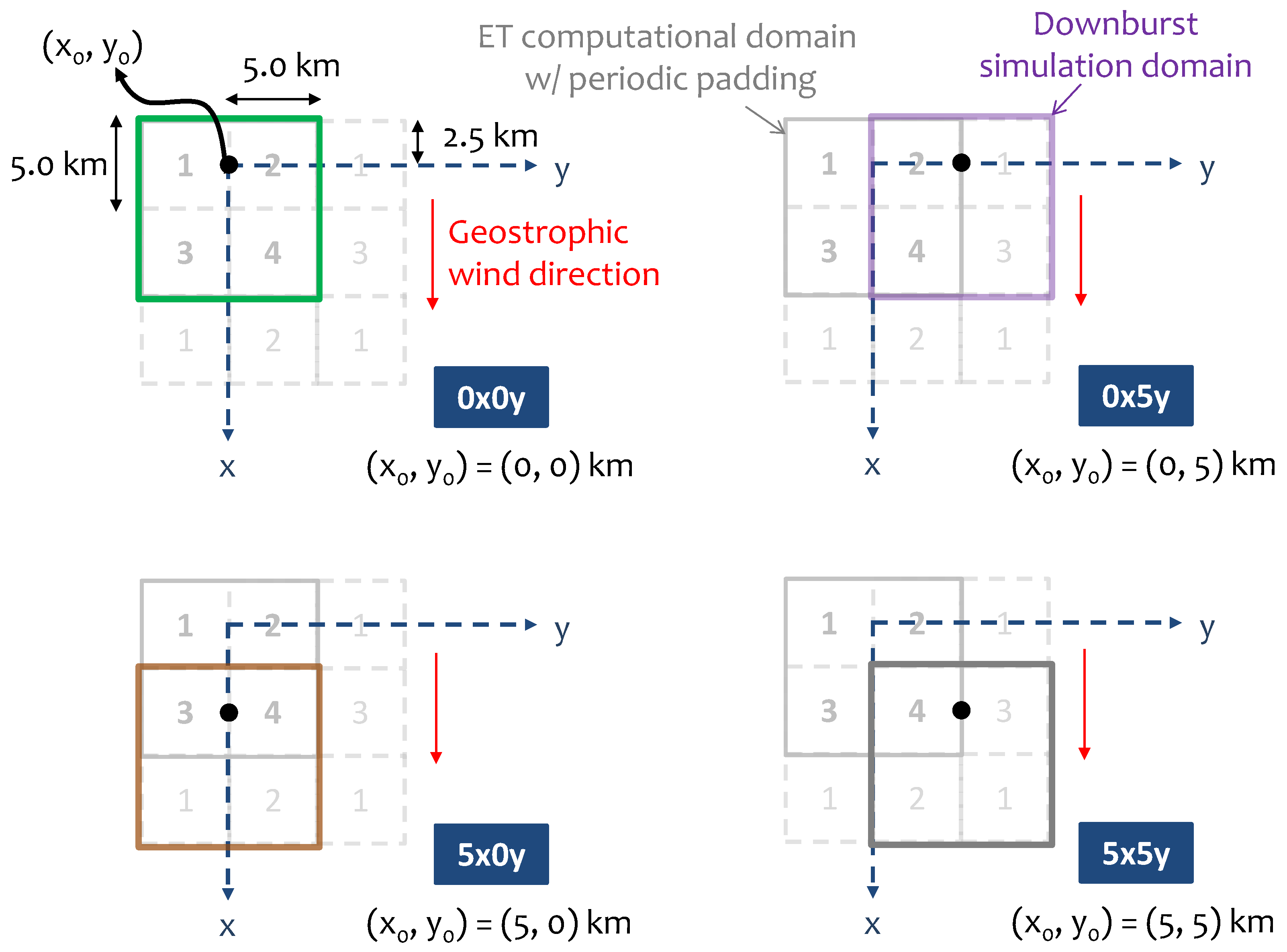

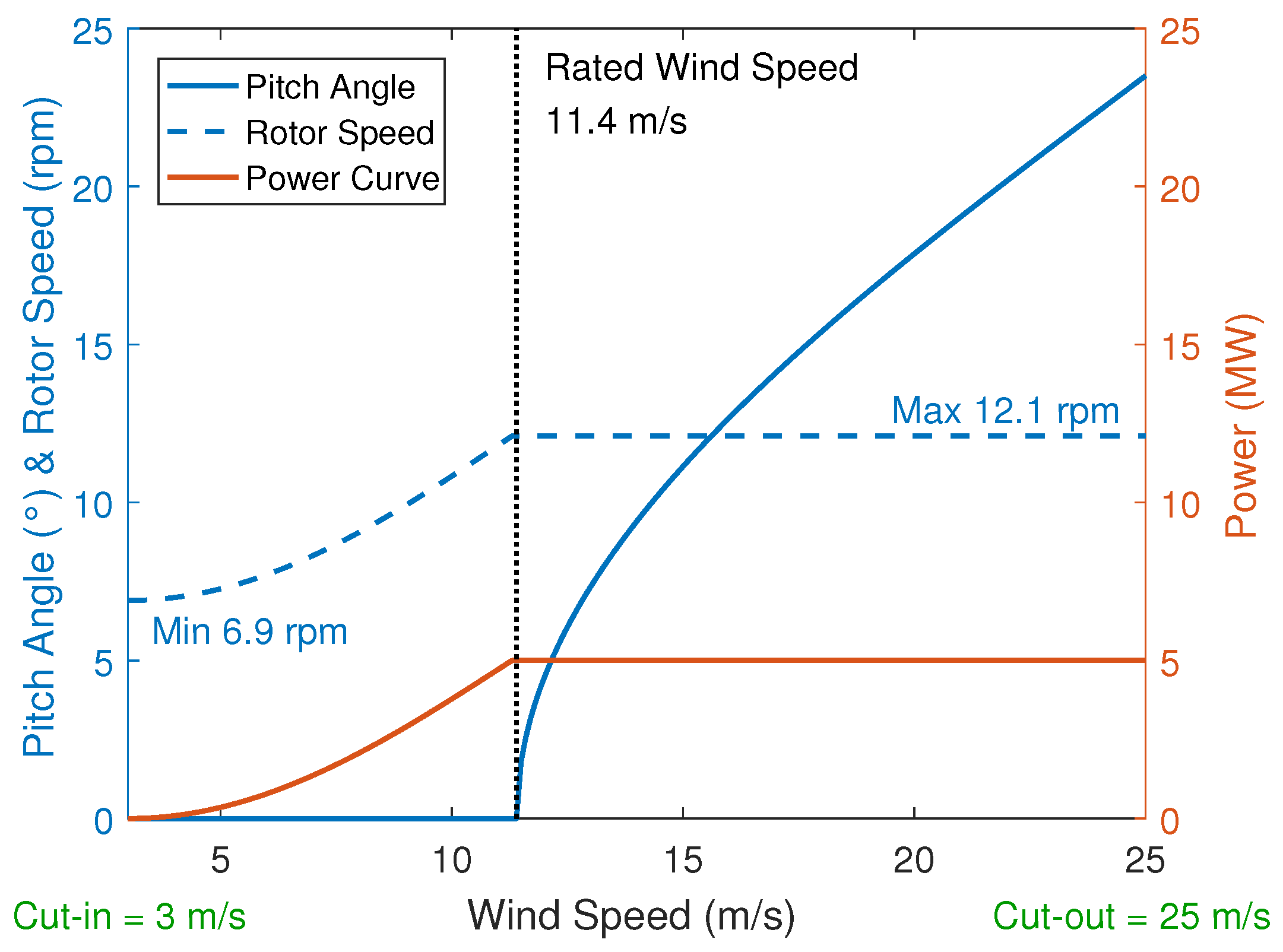
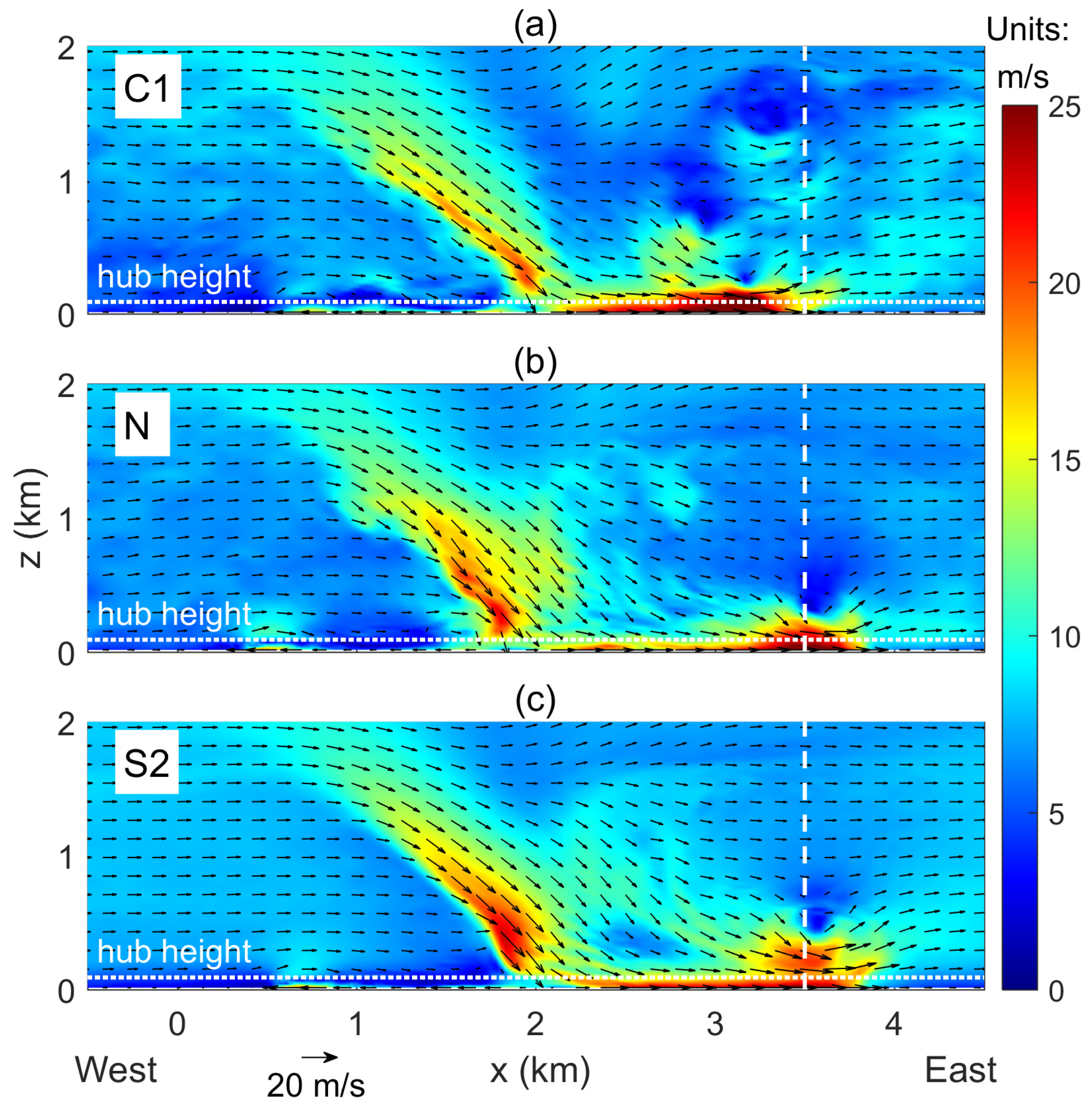
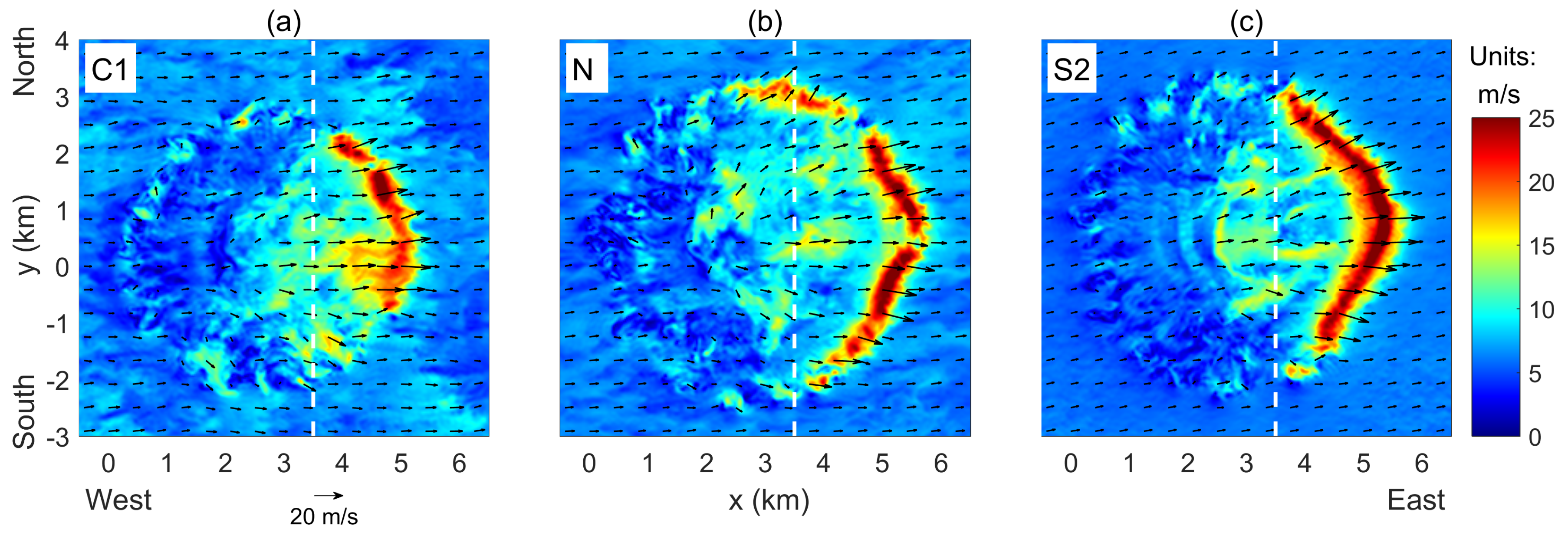
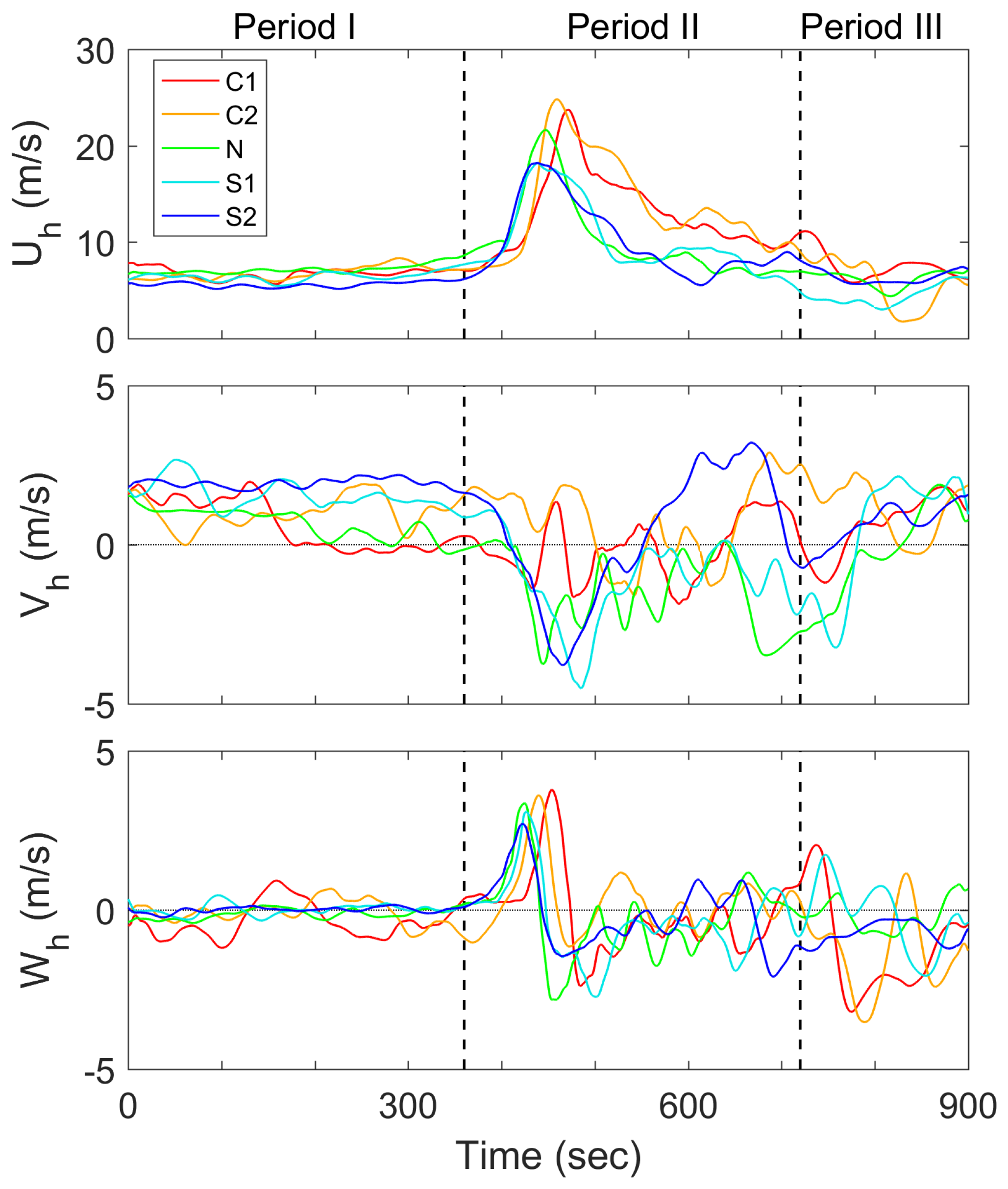
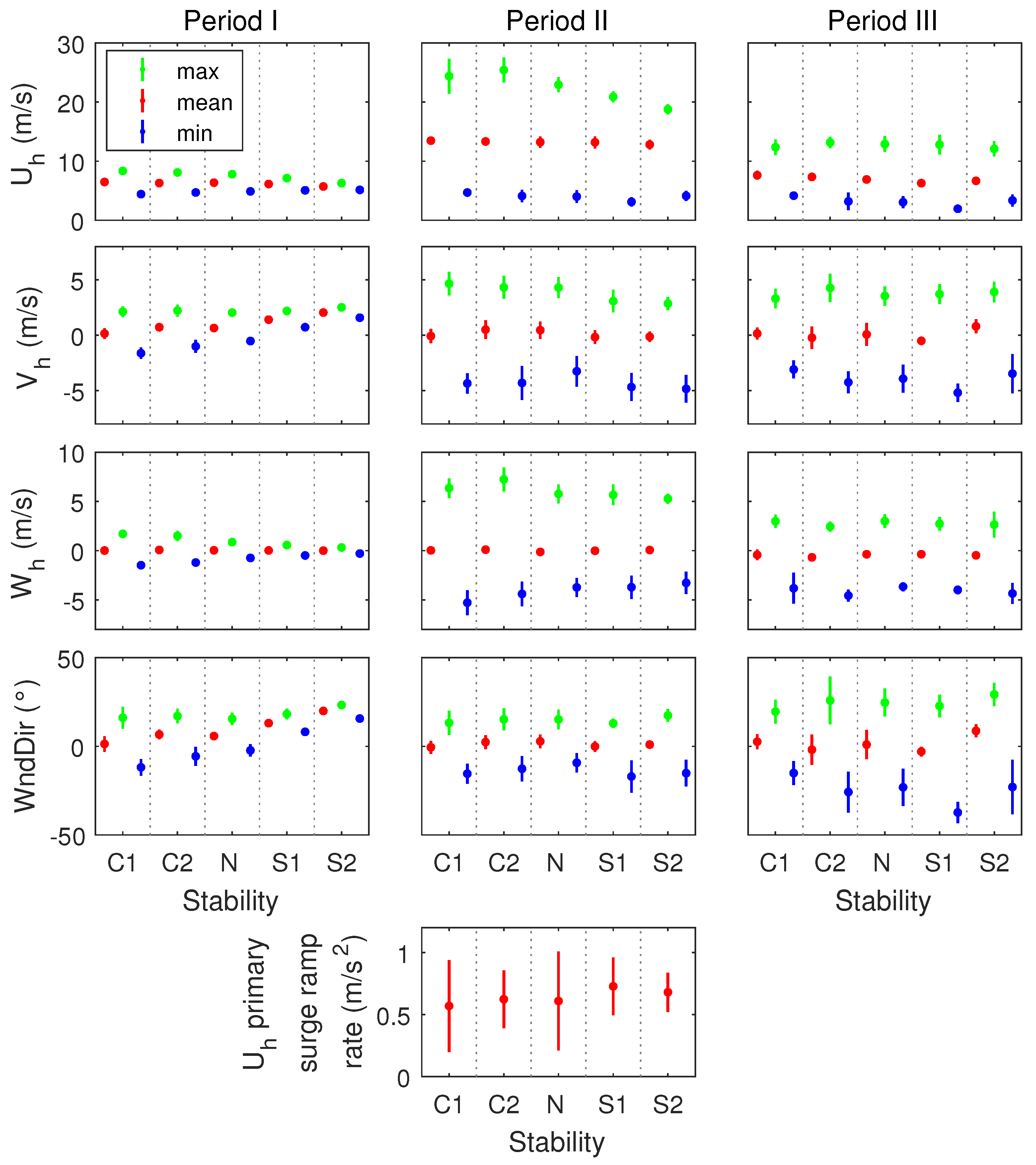



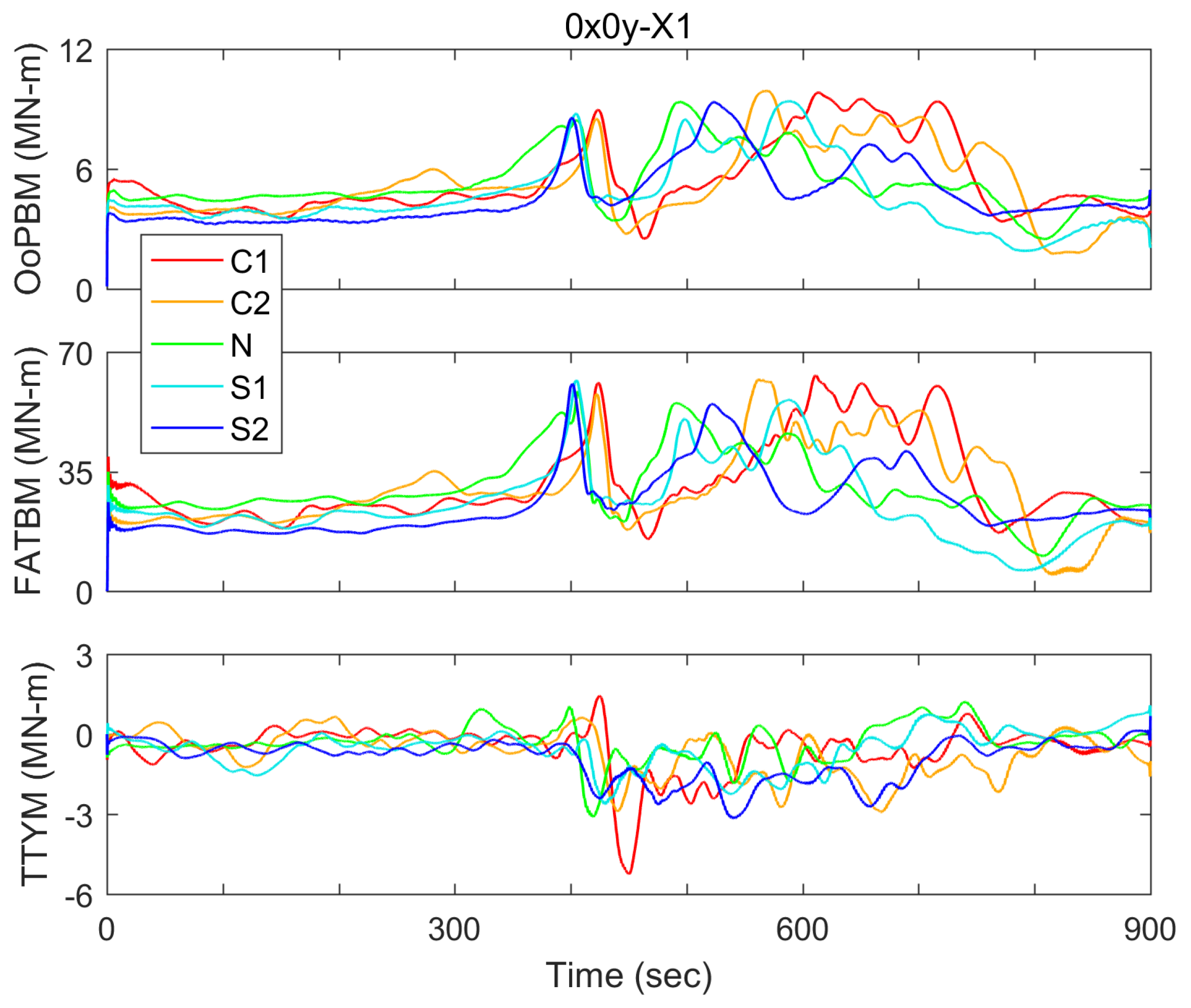






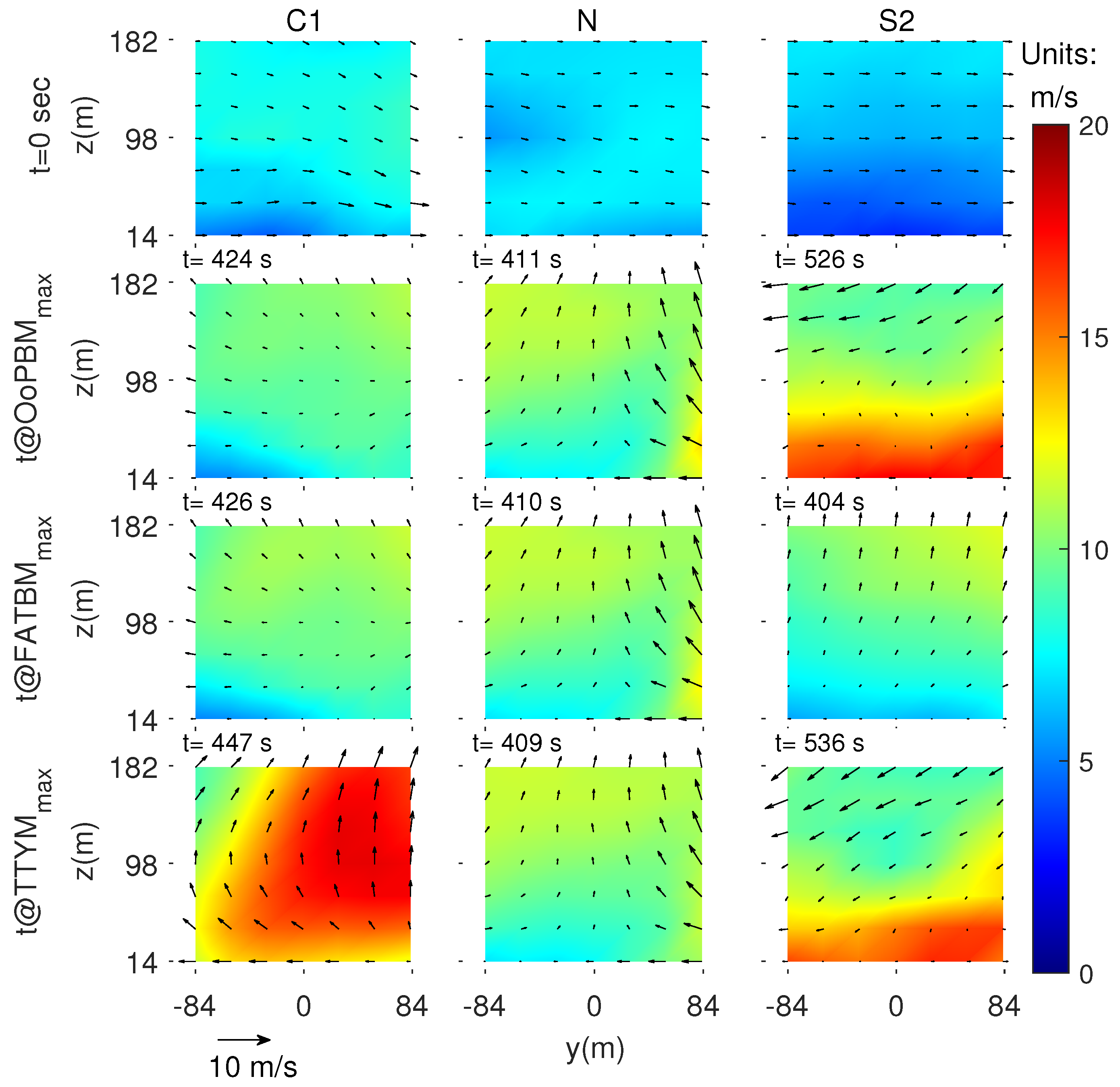
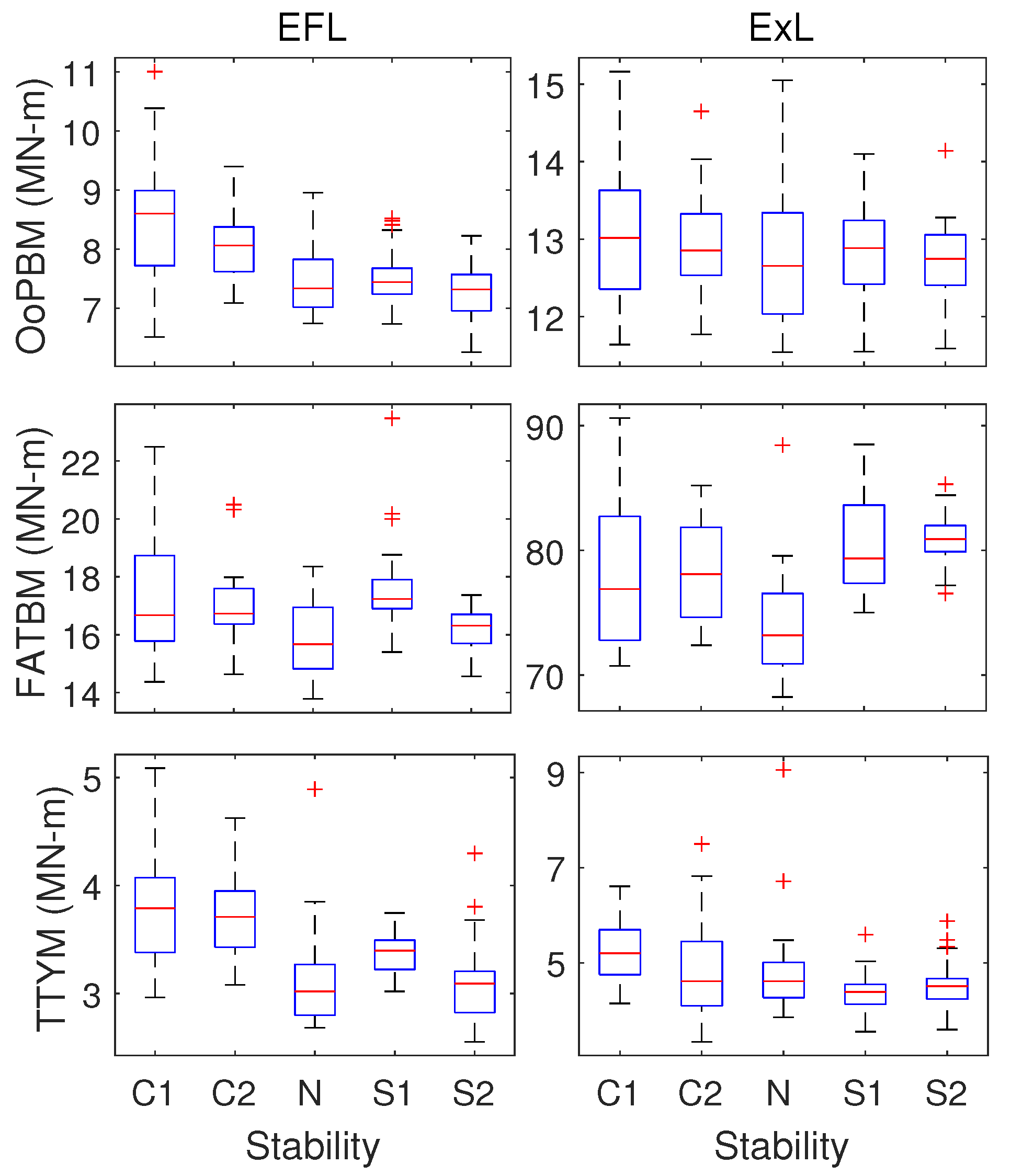

| Properties and Dimensions | Values |
|---|---|
| Power rating | 5 MW |
| Rotor type | Upwind/ 3-bladed |
| Rotor diameter | 126 m |
| Hub height | 90 m |
| Cut-in, rated, cut-out speed | 3, 11.4, 25 m/s |
| rated rotor speed | 12.1 rpm |
| Rotor mass | 110,000 kg |
| Nacelle mass | 240,000 kg |
| Tower mass | 347,460 kg |
| No. | Stability | Downburst Initial Location |
|---|---|---|
| 1 | C1 | 0x0y |
| 2 | C1 | 5x0y |
| 3 | C1 | 0x5y |
| 4 | C1 | 5x5y |
| 5 | C2 | 0x0y |
| 6 | C2 | 5x0y |
| 7 | C2 | 0x5y |
| 8 | C2 | 5x5y |
| 9 (control) | N | 0x0y |
| 10 | N | 5x0y |
| 11 | N | 0x5y |
| 12 | N | 5x5y |
| 13 | S1 | 0x0y |
| 14 | S1 | 5x0y |
| 15 | S1 | 0x5y |
| 16 | S1 | 5x5y |
| 17 | S2 | 0x0y |
| 18 | S2 | 5x0y |
| 19 | S2 | 0x5y |
| 20 | S2 | 5x5y |
| Wind Speed | Wind Ramp Rate | Wind Dir. | Wind Dir. Chg. | Yaw | OoPBM | OoPBM | TTYM | |
|---|---|---|---|---|---|---|---|---|
| Max. (m/s) | Max. (m/s) | Change (deg) | Rate (deg/s) | Control? | ExL (MN-m) | EFL (MN-m) | ExL (MN-m) | |
| Case 3b | 55.0 | 1.0 | 110.0 | 1.2 | Yes | 22.5 | / | 26.8 |
| Nguyen et al. [10] | ||||||||
| Case 2 | ~32.0 | / | ~63.0 | / | Yes | 12.3 | 6.9 | / |
| Nguyen and Manuel [13] | ||||||||
| Present Study | 28.8 | 1.6 | 21.3 | 4.8 | Yes | 11.7 | 8.1 | 6.6 |
| C1-0x0y-X1 |
© 2019 by the authors. Licensee MDPI, Basel, Switzerland. This article is an open access article distributed under the terms and conditions of the Creative Commons Attribution (CC BY) license (http://creativecommons.org/licenses/by/4.0/).
Share and Cite
Lu, N.-Y.; Hawbecker, P.; Basu, S.; Manuel, L. On Wind Turbine Loads During Thunderstorm Downbursts in Contrasting Atmospheric Stability Regimes. Energies 2019, 12, 2773. https://doi.org/10.3390/en12142773
Lu N-Y, Hawbecker P, Basu S, Manuel L. On Wind Turbine Loads During Thunderstorm Downbursts in Contrasting Atmospheric Stability Regimes. Energies. 2019; 12(14):2773. https://doi.org/10.3390/en12142773
Chicago/Turabian StyleLu, Nan-You, Patrick Hawbecker, Sukanta Basu, and Lance Manuel. 2019. "On Wind Turbine Loads During Thunderstorm Downbursts in Contrasting Atmospheric Stability Regimes" Energies 12, no. 14: 2773. https://doi.org/10.3390/en12142773







